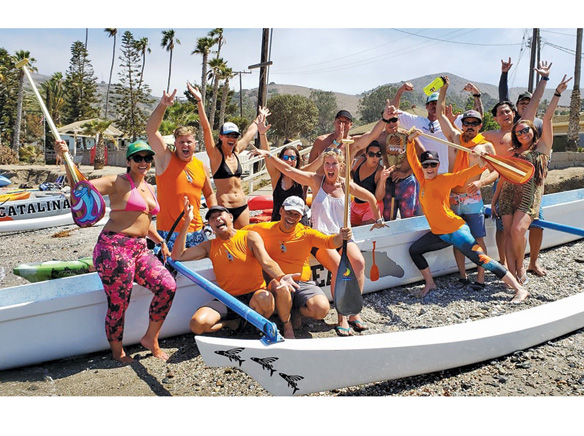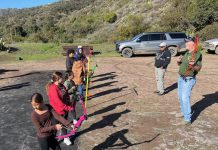
Excited men and women from Catalina Island recently celebrated after a 26-mile paddle (from Avalon Bay to the Isthmus and back) as they prepared for what many call the Super Bowl of paddling.
More than 100 outrigger canoes are expected to participate in the “Catalina Crossing” races slated for Sept. 8 and 9. Sanctioned by the Southern California Outrigger Racing Association, the races are considered the “U.S. Outrigger Championships.”
While Catalina Island once had thriving “outrigger clubs,” interest apparently dwindled in recent years until the City of Avalon decided to invest in bringing back interest in the sport,” according to Recreation Director David Hart.
“The interest is growing again,” said Hart, adding that Catalina will field teams in both women and men’s competition for the upcoming races. The revival in the sport here reflects an international revival that began two decades ago in Hawaii.
Outriggers are double hulled canoes about which first accounts date back to 200 A.D. as Polynesians discover large Koa trees that could be carved into sturdy, long canoes. They found plants and substances that actually waterproofed their canoes.
Since their lands were both mountainous and were islands separated by water, the natives discovered traveling by sea was dangerous, yet far more productive. They began following the direction of migrating birds and not only discovered the Hawaiian Islands, now a mainstay of the outrigger industry.
As they ventured out into choppier seas, the ancestral canoe builders learned that an ama, or physical outrigging, could be connected to the canoe to provide greater stability. The ama is thought to be the root of a Polynesian word meaning stability.
Most amas are connected to the left side of canoes, which does vary, but is generally thought to be part of a tradition on the left because the trees in Polynesia have a distinct leftward bend due to a combination of the Coriolis effect and the tradewinds.
Today, canoes are made from fiberglass and weight around 400 pounds. The symbolism still remains, though and more and more coastal and island areas are forming outrigger clubs, said Hart.
He said the Catalina Crossing championships involve canoe races from Catalina Island to Newport Beach. The women race on Saturday and will depart from Newport Beach and the men’s canoes will leave on Sunday from Catalina and race to Newport Beach.
The men’s course requires them to paddle all of the way inland in Newport, a few miles longer. The woman’s course is about 28 miles across the Catalina channel and the men’s course is about four miles longer, he said.
The first outrigger race held in California was on September 20, 1959. This first race was a long-distance race from Avalon on Catalina Island to the Newport Dunes inside the California Coast.
According to Hart, each team, either of women or men, consists of nine members. There are six people paddling, including one steersman, at the back of the boat that has a special role in keep the canoe on track.
A chase boat follows the canoe and pulls alongside the canoe every 20 minutes as three paddlers literally jump out of the canoe and three fresh paddlers jump in.
While it generally takes four to five hours for the outriggers to cross the channel, some Polyensian and Hawaiian teams have completed the course much faster.
“Although the teams take the race quite seriously, it is a lot of fun,” he said.
While some of the first canoes back in the 50’s were made of Koa wood, most modern canoes are made of fiberglass, and some now are even made of carbon fiber materials. They are dramatically faster as high tech has now been fully integrated into this most original antique tradition.
Most of the teams will compete in the spec class, while some of the more advanced teams will compete in the “unlimited” class, which he said is the carbon fiber boats. Hart said the city and the business community are coordinating efforts to house the teams coming in for the race and the Catalina teams are busy preparing as well. Hart said more than 100 canoes are expected to compete, with teams coming in from all over California and other outposts as well.










